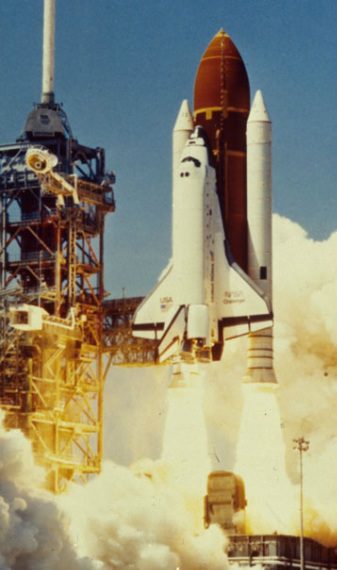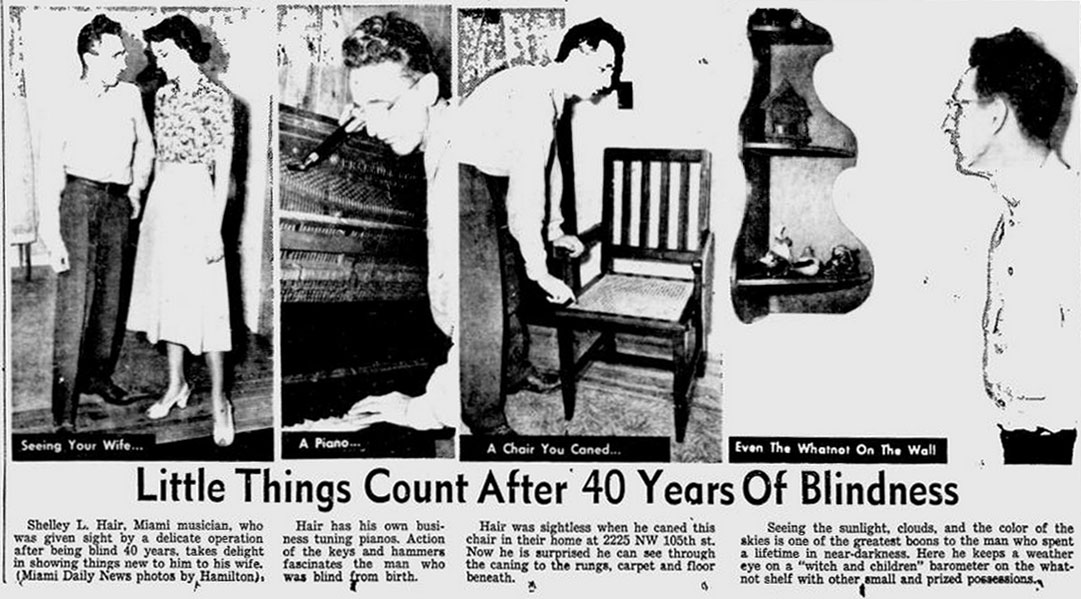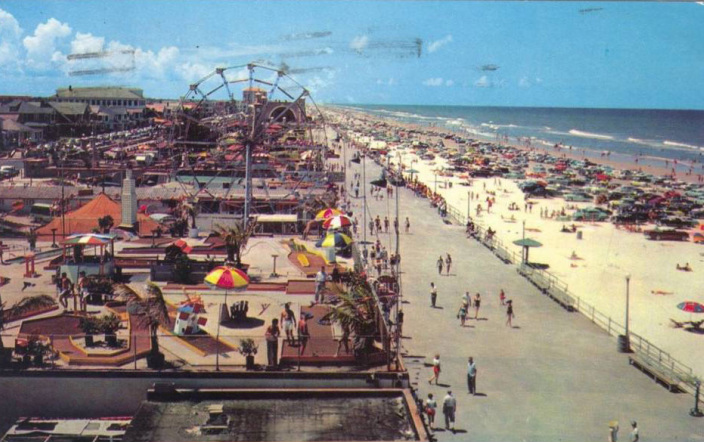Jan. 31, 1960: First nationally televised auto race airs from Daytona
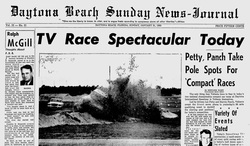
It wasn't the Daytona 500, but an estimated 17 million tuned in to "CBS Sports Spectacular" to see the first nationally televised race from Daytona. Averaging 88.134 mph, Marvin Panch drove a "pepped up" 1960 Plymouth Valiant to victory in each of two national championship compact car races, the Daytona Beach Morning Journal reported. The broadcast spotlighted the Daytona International Speedway, which opened the year before, in 1959. Unfortunately for tourism promoters, viewers saw race fans in the stands "bundled to the ears," making it look colder than the official 54 degrees. The network brought eight cameras to the track, was able to show drivers inside their cars, but missed a key spill during a commercial. America's favorite newsman Walter Cronkite called the race along with Art Peck. A segment taped the previous day of Cronkite circling the track aired in the opening sequence of the telecast. Read the stories in the Daytona Beach Morning Journal: Fan, In Easy Chair At Home, Got Real Feeling Of Race and Panch Sweeps Compact Races. Also see TV Producer Says Speedway Coverage Proves Challenge
Jan. 30, 1951: Production underway in Sarasota for "Greatest Show"
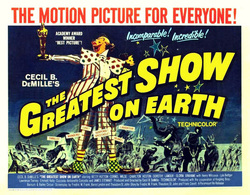
Hollywood stars, stunt workers and production crews converged on The Ringling Brothers Circus' Winter Quarters in Sarasota to film scenes for Cecil B. DeMille's opus, "The Greatest Show on Earth." An account in the Sarasota Herald Tribune describes the "staunch test of courage" required of stars Betty Hutton and Cornel Wilde as they rehearsed trapeze acrobatics. "Boy it's high up here, and am I scared," Betty shouted to the crew below before nailing the stunt and spreading grateful hugs. Hundreds of Sarasota residents were employed as extras. In addition to Hutton and Wilde, the movie starred Charlton Heston, James Stewart and Dorothy Lamour. It won the Academy Award for Best Picture. Read two stories in the Sarasota Herald Tribune: Betty Flies Through the Air -- Handsomely and 2 More Movie Stars Arrive; Cameras Grind
Jan. 29, 1975: Bradenton principal indicted in plot to kill husband
Emma C. Harvey, 54, a Bradenton elementary school principal, was indicted on charges she hired three people to kill her husband, a 62-year-old. landscaper. John Harvey was found stabbed to death in his home after police received a tip from an anonymous caller. Emma Harvey was out of town on the night of the killing. The investigation later determined she gave a former student $1,000 to have her husband killed. The student recruited two men for $250 each. But after they committed the crime, the former student confessed her involvement, leading to swift arrests of Emma Harvey and the two killers. All three later received life sentences. The former student was not charged. Read more in these Sarasota Herald Tribune stories: Harvey Murder Case Indictments Returned and Braadenton Hits Pulp Magazine Headlines
Jan. 28, 1986: Space Shuttle Challenger blows up
|
Like Sept. 11, 2001 or the Kennedy assassination in 1963, everyone remembers where they were and what they were doing when they heard about or witnessed the Challenger disaster.
We asked our Facebook friends to recall. Larry J. Leech II - I had just taken a break from shooting basketball with a friend at the YMCA in Uniontown, Pa. He went to the lobby to get a drink of water. He returned and announced the shuttle had just exploded. I told him to shut up, that it wasn't funny to joke about something like that. When I realized he wasn’t joking I went into the lobby and called my mother on a pay phone. Being from Melbourne, Fla., I knew the importance of the shuttle program to the Space Coast. Crying, mom answered. When she confirmed the news, I stuck my head into the gym and told my friend that I needed to leave. I hurried home and spent the rest of the day with my mom in front of the television. We found out later that my grandfather was taking pictures of the launch from his backyard in Melbourne. He snapped two of the explosion. I still have those pictures. Thomas Ninesevenx Allison - I was in college and working as a substitute at Campbell Middle in Daytona. We had the launch tuned in on the class TV and watched it leave the pad then went outside to watch it in the sky. I remember vividly, standing with my students and then seeing it explode and I seriously said, " I have never seen a rocket do that." Then I took the kids back inside as we watched the TV waiting. I knew something was wrong but didn't want to upset the kids so we shut the TV off. It was after school was out that I heard what had happened. |
David Grimsley - It was my senior year at FSU, and I had a big research paper due for one of my Psychology classes. I had to skip my morning class to give me enough time to put the finishing touches on the paper due later that day. I distinctly remember sitting cross-legged on the floor with the TV on in the back-ground, while working on the paper. As the space shuttle was launched, I took a break and looked up to watch. As I watched the explosion, I was immediately unsure if it was supposed to look that way, but quickly got that unnerving feeling and quickly understood something horrible had happened. I must have watched the newscast for the next 2 hours. I'm guessing the paper got completed, but I will never forget that morning. |
|
Dana Porter Burgner - I had the tv on while I was cleaning a condo in the Sechelles building in Daytona Beach Shores. They were showing the faces of the family members of the astronauts watching the launch. They looked shocked and I went out on the balcony to see what they were seeing. The explosion had already happened and the trails in the sky didn't look right. I went back inside to watch the live coverage on TV and cried for the family members who had lost their loved ones.
Jerry Battiste - Standing in the parking lot of Spruce Creek High School I saw the launch, then the twisted clouds and the scattered contrails. Other kids were saying how cool the shuttle looked launching, but I knew instantly something was wrong, having watched every shuttle launch up until that time. I remember when my worst fears were eventually confirmed I felt a hollowness inside me; a heavy black stone in the pit of my stomach that remains to this day. Jeff Martin - I was standing in the south parking lot of our old car lot just north of 3rd and Center in Holly Hill. We all had a clear view of it. It was a hard freeze the night before, and we were at the lot checking for damage. Looking up to watch, suddenly, it happened. We were all dumbstruck. A couple people were speculating that the shuttle had been blown free by the explosion, and hoping it (the shuttle) would be recovered intact. We found out the truth much later. A sad day in our history. Randy Rorrer - I was driving to work on I-4 and saw the smoke flume from where the shuttle went up. I was in a Suzuki Samurai jeep with the top down. I couldn't for the life of me figure out why the flume suddenly stopped. When I got to the N-J offices, I couldn't figure out why everyone looked so glum. I hadn't heard the news because I was undoubtedly listening to a Jimmy Buffett cassette, and I asked somebody "Did somebody die or something? What's wrong with everybody around here?" Worst case I've ever had of "open mouth, insert foot." Traci Ware - I was watching from a window in Orlando and then was glued to the TV for a week, it was very sad. Tamee Kearns-Johnson - I knew there was going to be a launch that day (still living in Fla at that time) walked outside to see and saw 2 smoke trails and knew something had gone horribly wrong. About that time the music on the radio had stopped and news broke in to let people know. Nick Conte - I was driving home, in my car on the corner of Nova road and Beville. Looked up to see the launch - we all had become so nonchalant about them - saw the different smoke plums. Felt "That was odd" but the full scope did not hit me until I arrived and saw my Mom sobbing in the living room saying "It exploded" - like 9/11, you knew exactly the spot you were standing on when you heard the news. John Bozzo - I was working on the copy desk at the Times-Union. I swear I read an AP story the night before about the O-rings and sensitivity to cold, so I didn't expect a launch. I worked past midnight and was up late. I got a call from a family member telling me what happened. I was supposed to be off the day of the tragedy, but I suggested that i come in to work and they agreed. Paul Stump - It was lunchtime where I was teaching at Spruce Creek High School, 60 miles away from the launch site. Another teacher ran into my room, and shouted that the Challenger just exploded. Incredulously, I took off outdoors, to see vapor trails or smoke trails that eerily looked like white fireworks under the sunshine. Leandra Bates - I was in elementary school watching it on tv when there was a sudden explosion. Living in Satellite Beach, Fl I have seen many shuttles launch and this time it was different. My grandparents called and said their windows in the back of their house exploded when the shuttle blew up. They were outside watching it take off. They said the explosion was so loud it shook the whole house. So sad... very sad day for N.A.S.A. and their families. Tony Jones - I was in the fifth grade, and the teachers brought a television in and we watched it live. I'll never forget Mrs. Wente - one of the meanest teachers ever - breaking down and crying in front of us as we watched the horrors. RIP to those brave souls. |
Bill Zimmerman - I lived in Ocala and was leaving high school early, feeling sick. Got to the car and said hi to my dad when he shushed me and turned the radio up; the radio broadcast just had the sound of mission control asking Challenger's crew to respond and hearing only silence. We looked up and could see the scattered contrails on a nearly perfectly clear day. Got home and watched CNN the rest of the day.
Joe Martincic - I remember that day. I was working at Briley, Wild and Assoc. at US1 and Airport Rd. in Ormond Beach. I'm pretty sure it was the first one to go up I didn't go out and watch. I was in the break room when a fellow employee came in and told me the shuttle blew up. I didn't believe him at first, so he told me to go out and look. When I saw the trails from the solid rocket boosters I knew something had gone terribly wrong. I went back in and everyone was gathering around a TV to find out what happened. I remember heads shaking in disbelief, hearing questions that had no answers yet, spontaneous hugs and tears being shed, a few of which were mine. I also remember wondering why NASA didn't have more camera angles than they were showing us at the time. I had a feeling they had footage that showed what happened but wouldn't show it. I was right. Eric T. Deem - Standing in accountability formation after lunch at Fort Bragg. Unit commander came out to address us that the shuttle had blown up. The one thing that disturbs me about the whole thing was the question if the astronauts survived the initial explosion....plenty of evidence saying they did.....and didn't. And what really pisses me off is they built all the shuttles on the cheap; irresponsible when N.A.S.A.'s own tests PROVED that titanium was the way to go...had the shuttle been built with titanium skinned wings and body, Columbia a few years later MIGHT have survived re-entry. Stacy Taylor Dearden - I was in South Seminole Middle School in central Florida and the entire school was out on the hardtop to watch it take off as it was the first teacher to go to space. When it blew up there was an announcement over the intercom that something went wrong and when they knew more the would announce it and to take students back to class. I'll never forget it because what followed was dead silence. The entire middle school students were quiet and so many of the teachers were sobbing. I remember my teacher asking me to find out anything I could from my grandfather as he was Chief of Ground Safety for Nasa in the 60's and was there watching the take off as he still had quite a few friends out there and some clout with the powers that be. He had come and spoke to the class before the "historical launch" to give us some insiders knowledge. I'll never forget it. R.t. Beese - I was in 5th grade at SD Spady Elementary in Delray Beach. They had us all outside and we all initially thought it was the boosters were coming off, but were then ushered back inside. I responded with humor at first because I didn't know how to react, I cried at home later. Andrea Everson - It was my first winter in FL, I was only 7. We were in a Field Trip to Morikami Museum. The day was crisp and clear. There was a cloud like gray line in the sky. Some lady came over to us and told us what had happened. It wasn't until I OT home and saw it on TV that the full force of it hit me. Even though I was 7 I knew that things had changed forever. Vanessa Brown Taylor - Yes i remember it like it was yesterday.Iam a local born and raised in NSB.My Grandfather (who raised me) & my uncle whom both retired from the cape as pipefitters.I was driving down the road & heard it on the radio as i was unable to watch it that day due to work.I immediatly pulled over and busted out crying.You see every day when my papa & uncle would get home from work the conversation around the dinner table was all about the cape.It was a very sad day for me,my family,& the whole world...GOD BLESS. Judy Davis - I was watching it out of our front window (which faced the Space Center directly to the East). The school children here in Titusville (North Brevard County), FL were all out of their classrooms watching and had to be escorted back into buildings. The adults especially and some of the younger children still remember that sad event to this day. Janet Sullivan Sabaka - I was teaching first grade. We were watching the launch on tv, and I immediately knew something was wrong....the trails were not right...a very sad day indeed, and the first time my kids saw me cry. |
Jan. 27, 1964: Visitors with out-of-state tags warned about thieves
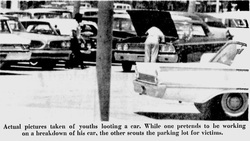
No one with a stake in Florida's tourism economy likes to dwell on it, but sometimes visitors are targeted by thieves. The Miami News underlined this point with a warning to people driving cars with out-of-state tags. The previous year, thieves looted 1,564 cars in Dade County and swiped $188,502 of loot. Just 157 of the cases were solved, and $5,882 of the loot was recovered. One thief kept a nice Miami Beach apartment off the money he earned looting cars, the paper said. The Miami Police Department's chief detective warned motorists with out-of-state tags to lock their cars when they go to the beach and don't bring any valuables along. Read the story in the Miami News: Invitation To Steal: Out-Of-Town Tags
Jan. 26, 1979: Fishermen rescued after 4-day battle with storm
Four fishermen were rescued by a Navy destroyer following a harrowing four-day battle with an Atlantic storm that spawned 35-foot seas and 75 mph winds. The men's 35-foot snapper boat lost battery power 35 miles northeast of Cape Canaveral and was pushed more than 600 miles before a lookout on the Navy ship saw a light on the small boat. As the storm raged, "we were knee deep in water and bailing with five-gallon buckets," one of the men said. Men on the Navy boat threw lines to the fishermen, who each tied them around his waist, jumped into the water and was pulled to the destroyer. "It's a miracle they're alive. Praise the Lord," said the captain's wife after reuniting with her husband in Jacksonville. Read the Associated Press story in the Daytona Beach News-Journal: Fishermen Saved After 4-Day Battle With Storm At Sea
Jan. 25, 1947: Al Capone dies in Miami Beach
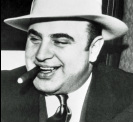 Capone
Capone
One of America's most notorious and feared gangsters, Al Capone, died of heart failure at 48 in his walled Palm Island estate four days after suffering a stroke. Capone ruled the Chicago underworld during the days of prohibition, operating speakeasies, and gambling rings, corrupting law enforcement officials, and ordering hundreds of deaths in legendary gangland turf wars. Capone bought the Miami Beach villa through an undercover agent in 1928 and moved in on Easter Sunday, 1930, despite a legal fight by Florida authorities to prevent the gangster from settling in the state. He was indicted the next year on charges of income tax evasion and served more than seven years in prison.
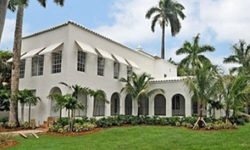 Capone's Palm Island house
Capone's Palm Island house
He moved back into the Palm Island house after his 1939 release but spent his final years suffering mental and physical deterioration from late-stage neurosyphilis. Read the New York Times story, Capone Dead At 48 • Read the Miami News story, Capone Dies at Island Villa • Learn more about Al Capone at the Chicago Historical Society's web site • See photos of Capone's house
Jan. 24, 1989: Serial killer Ted Bundy executed
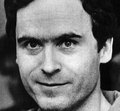 Bundy
Bundy
Ted Bundy, one of the most prolific serial killers in American history, was executed by electric chair at Florida State Prison in Starke. The execution capped a decade-long legal effort to avoid his death sentence for the kidnapping, rape and murder of a 12-year-old Lake City girl. Bundy, the subject of books and movies because he was able to lure victims with his boyish charm and charisma, is considered responsible for the murders of at least 30 women and girls during a four-year killing spree between 1974 and 1978. Read the story in the Ocala Star Banner: Bundy dies; crowd cheers
Jan. 23, 1927: Sheriff vows arrests for auto tag scofflaws, unless...
Woebetides to Pinellas County motorists who failed to renew their auto tags. The sheriff announced plans to send "a full squad of county traffic officers" the following day to arrest owners with expired tags. Violators will be held under bond to appear before the local magistrates, the St. Petersburg Times reported. Records show many motorists had failed to renew their tags despite being given almost a month to do so, the report said. "All persons, regardless of their standing in the community, will be arrested." Paper tags reading "license applied for" will not be accepted as excuses. But "visiting motorists, particularly those from the north, will be dealt with more leniently, it is understood."
Read the story in the St. Petersburg Times: Sheriff Begins Enforcement of Tag Law Today
Read the story in the St. Petersburg Times: Sheriff Begins Enforcement of Tag Law Today
Jan. 22, 1951: 40 years of darkness end for blind Miami musician
It wasn't Miami's tall buildings and broad beaches that most interested Shelley L. Hair after surgery allowed the musician to see for the first time in his 40 years on Earth. "Color, horizon, perspective -- and little things around the house like handles and hinges and knotty pine walls hold all the fascination that they do for an infant discovering them for the first time," reported the Miami News. A Kentucky native, Hair was blinded three days after birth by a too-strong solution of silver nitrate placed in his eyes. His right eye was destroyed and later removed. His left eye could only distinguish light and dark. He learned to play piano, organ, trumpet and accordion and, after moving to Miami, became a well-known nightclub performer. His biggest challenge after the operation was learning to adjust to the illusion of common objects like light switches, electrical outlets and cupboard handles leaping out of their backgrounds. He became ill for three days after seeing a mosaic floor of many mixed colors. But those "temporary upsets" were offset by the joy of seeng his wife and the world. Hair stopped performing in nightclubs, though, as the smoky atmosphere became too irritating to his new good eye. Read the story in the Miami News: Sight restored, Man Marvels at Nature
Jan. 22, 1912: Florida East Coast Railroad completed through Keys
From Florida Historical Society: The Over-Sea Railroad, the final link in the Florida East Coast Railway was completed on this date. The culmination of a decades-long vision of Standard Oil tycoon Henry M. Flagler, the Oversea Railroad stretched over 100 miles out into open ocean, connecting Key West with the Florida mainland. The project cost $430 million dollars and included some incredible feats of engineering, most notably a seven mile long span connecting Knight’s Key with Little Duck Key. The project made rail travel possible along a single line from Jacksonville to Key West via Flagler’s Florida East Coast Line. As well as railroads, Flagler built luxury hotels and platted entire cities for the purposes of developing the east coast of Florida. Shortly after completion of the Oversea Extension, Flagler died in May of 1913.
Jan. 21, 1992: 1,500 lb Great White Shark caught off coast
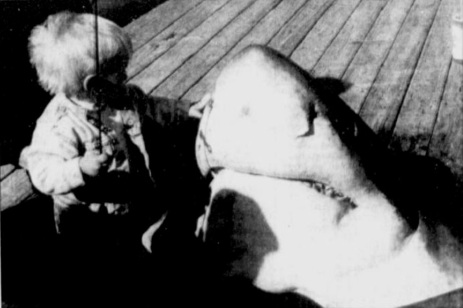 Nathaniel Welch checks out shark caught by his father, Rob Welch. AP photo
Nathaniel Welch checks out shark caught by his father, Rob Welch. AP photo
It took two hours to reel him in, but Rob Welch caught what was said to be the largest Great White Shark ever snagged off Florida. The 1,500-pound shark had to be cut into four pieces before it could be loaded onto the boat. Pictured here is Welch's 20-month-old son Nathanial with the shark's head. See the Associated Press photo and caption in the Lakeland Ledger: Big Catch
Jan. 20, 2007: Fmr. Sen. George Smathers dies at 93
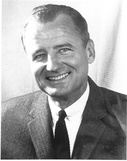
George A. Smathers, a longtime former congressman and senator, died with a mixed legacy. The Southern Democrat was elected to the U.S. House in 1946 and then spent 19 years in the Senate after defeating incumbent Claude Pepper in 1950. In Congress, he helped pass bills to create Medicare, the Small Business Administration and Everglades National Park. He was strongly anti-Communist, warning about Fidel Castro's rise to power in Cuba and strongly supporting the war in Vietnam. He forged friendships with John F. Kennedy and Lyndon Johnson and sold Richard Nixon a home in Key Biscayne. He also courted support among white segregationist voters. Though he supported voting rights for African Americans, he voted against the Civil Rights Act of 1964. He opposed Thurgood Marshall's nomination to the Supreme Court. He called the Brown vs. Board of Education decision, which outlawed school desegregation, illegal. When the Rev. Martin Luther King Jr. was jailed in St. Augustine, he offered to pay King's bail if King would would leave the state. After leaving office in 1969, Smathers amassed a fortune through lobbying and business ventures ranging from car dealerships to orange groves. He gave tens of millions to the universities of Florida and Miami. Read the story by the Associated Press: George A. Smathers, former Florida senator
Jan. 19, 1977: Snow falls in South Florida for 1st time
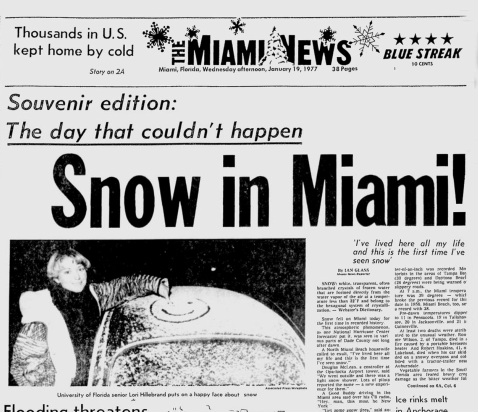 The Miami News, Jan. 19, 1977
The Miami News, Jan. 19, 1977
Snow fell on Florida and on Miami for the first time in recorded history. Delray Beach in Palm Beach County recorded a quarter of an inch of the white stuff. The Miami News published the definition of snow from Webster's Dictionary just under a headline that shouted, "Snow in Miami!" "A Good Buddy driving in the Miami area said over his CB radio, 'Hey, man, this must be New York.'" Schoolchildren ran outside to catch snowflakes on their tongues. Space heaters sold briskly and outdoor events were cancelled. While many delighted in the novelty, it was no fun for people who earned their living in the citrus and vegetable industry. The hard freeze that accompanied the snowfall wiped out jobs of some 150,000 migrant workers, including 80,000 in Miami-Dade County. The snow was caused by a combination of two arctic fronts. The second chilled the region so quickly that moisture that usually precedes cold fronts instead lagged behind, the Miami Herald said in 2007.
Read the story in the Miami News: Snow in Miami!
The Miami Herald remembers Jan. 19, 1977: The day it snowed in Miami
Read the story in the Miami News: Snow in Miami!
The Miami Herald remembers Jan. 19, 1977: The day it snowed in Miami
Jan. 19, 1957: Six students arrested for defying Tally bus seat law
Three African American students and three white students were arrested in Tallahassee when they violated a new city bus seating ordinance that replaced racial segregation, an Associated Press story said. The new policy "requires drivers to assign riders to numbered seats taking into account weight distribution on the bus, the need for preventing violence and other factors," the story said. Only three of the students were charged, and they were released on $50 bonds posted by the Negro Intercivic Council and ordered to appear in City Court on Jan. 21. An attorney for the National Association for the Advancement of Colored People said the cases "lend themselves to a legal test of the seat assignment ordinance." Read the story in the Daytona Beach Morning Journal: 6 Arrested in Hassle Over Bus Seating
Jan. 18, 1927: 500 realtors visit Florida, tour St. Petersburg
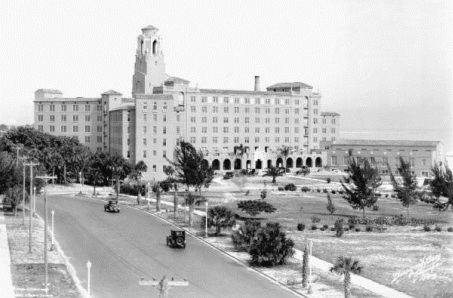 Vinoy Park Hotel, St. Petersburg.
State Archives of Florida, Florida Memory
Vinoy Park Hotel, St. Petersburg.
State Archives of Florida, Florida Memory
"Radiating the joy and unreserved wonderment of pilgrims in a new paradise," 500 realtors and city builders from 48 states were wined and dined on a tour of Florida during the Great Land Boom of the 1920s. Following a tour of Miami, the group was greeted by city fathers and Chamber of Commerce representatives from the Tampa Bay area and enjoyed a large banquet at St. Petersburg's Vinoy Park Hotel, according to the St. Petersburg Times. "The big party of visitors arrived in the city bubbling over with enthusiasm for Florida and all the wonders they so freely confessed had amazed them from one end of the state to the other," the story said. On a summer-like night, "crickets and little Florida tree frogs were chirping in the palms and vines on the green hotel parks. Music was played on the municipal pier." There was dancing and toasting and gifts, including Pinellas County lemonade, St Petersburg cigars, and a balloon-blowing contest to see who could talk enough Florida real estate "into the elastic to break the 'real estate bubble.'" After touring St. Petersburg the next day, the group was scheduled to visit Clearwater, Tarpon Springs, Orlando and Jacksonville before heading back to their home states and spreading the word about the magnificence of Florida. What could possibly go wrong? Read the story in the St. Petersburg Times: Visiting Realtors See City From Pier, Enjoy Dance, Dinner
Jan. 17, 1962: Hitchhiking duck adopts woman
Stop the presses for this Associated Press story from the Lakeland Ledger. Dateline: St. Petersburg. "Mrs. Lora P. Davis was adopted by a hitchhiking duck. She was driving in heavy traffic when she saw the duck on the street in front of her. She blew her horn. The duck didn't move. So she got out of the car to shoo it out of the way. It promptly fluttered in the open door and settled down. Now Mrs. Davis has a duck." • To prove we didn't make that up, read the story in the Lakeland Ledger: Hitchhiking Woman Adopts Duck.
Jan. 16, 1952: NSB claims 'Sunshine' crown for fastest ice melt
Says challengers cheated by using bathing beauties to help speed their melts
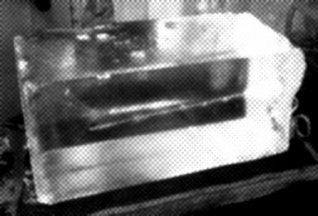
New Smyrna Beach laid claim to the "Sunshine City" crown after its one-ton block of ice melted down to 100 pounds in just 31 hours, 56 minutes, the Daytona Beach Morning Journal reported. Aided by "the power of pure, unadulterated Florida sun," the southeastern Volusia County city's ice block melted faster than ice blocks in Sebring, St. Petersburg and Orlando, the report said. Two Texas cities, Galveston and Corpus Christi, claimed the ice melting title, but a New Smyrna Beach official charged the two Texas cities, along with Los Angeles, broke the rules by allowing bathing beauties to come in contact with their blocks of ice. • Read the story in the Daytona Beach Morning Journal: Just Florida Sun Used to Melt NSB's Ice
Jan. 15, 1939: Tin Can Tourists roll into Tampa for 20th convention
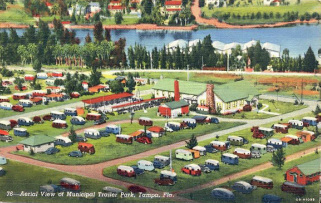 1939 postcard
1939 postcard
"Their traveling homes, which included a trailing dog house for a lucky pet, were strewn about Tampa's 100-acre municipal park," said an Associated Press news story announcing the first 1,200 rolling homes in town for the 20th annual convention of the Tin Can Tourists of the World. The event was a homecoming to commemorate the club's organization in Tampa in 1919. Over the years, the club would meet throughout Florida in the winter, with various cities competing to host the convention. By 1939, the gathering comprised "trailers of all shapes, sizes and descriptions, ranging from modest home-made quarters to luxurious meandering mansions, with air conditioning, French doors, built-in radio and electric ice boxes," the story said.
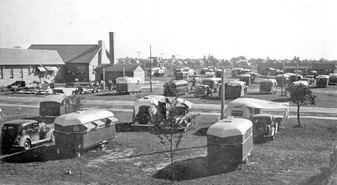 State Archives of Florida, Florida Memory
State Archives of Florida, Florida Memory
Oscar J. Peter of Winesburg, Ohio, was identified as "royal chief" of the group. He said the campers were retired business and professional people, pensioned government workers and northern farmers vacationing during the winter downtime. "Everybody here," Peter said, "is either tired or retired, and they've nothing to do but have a good time." • Read the story in the St. Petersburg Times: 3,000 Trailer Tourists Open Annual Meeting • See the Florida Memory Project's online exhibit: Tin Can Tourism • Browse Tampapix.com's online gallery: Tampa's Tin Can Tourists • Modern Tin Can Tourists website
Jan. 14, 1918: Paper boasts Miami is warmest place on U.S. map
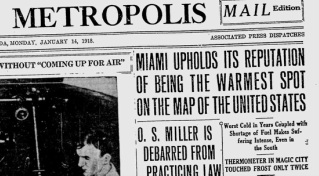 Miami Daily Metropolis, Jan. 14, 1918
Miami Daily Metropolis, Jan. 14, 1918
It's no wonder 5.6 million are jammed into South Florida's tri-county metro region, according to the 2010 Census. The Miami area's mild winter weather has long been a subject of relentless media hype, as evidenced by a Jan. 14, 1918 story in the Miami Daily Metropolis that bragged, "Miami Upholds Its Reputation Of Being The Warmest Spot On The Map Of The United States."
The story summarized treacherous winter weather in the north: deadly tornadoes in Georgia and Alabama, blizzards in Chicago and New York, temperatures below zero in St. Louis, freezes in New Orleans, and highs barely above 60 in Los Angeles. "Visitors from the north who have come to Miami tell harrowing tales of suffering and distress in the large cities there, persons starving and freezing because of food and fuel shortages due to deep snow, ice and demoralized traffic conditions," the story said.
The story summarized treacherous winter weather in the north: deadly tornadoes in Georgia and Alabama, blizzards in Chicago and New York, temperatures below zero in St. Louis, freezes in New Orleans, and highs barely above 60 in Los Angeles. "Visitors from the north who have come to Miami tell harrowing tales of suffering and distress in the large cities there, persons starving and freezing because of food and fuel shortages due to deep snow, ice and demoralized traffic conditions," the story said.
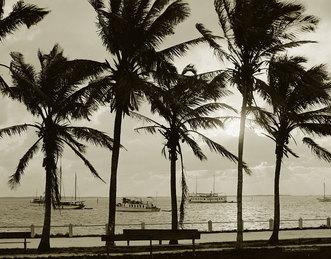 Biscayne Bay, sometime between 1910 and 1920.
Biscayne Bay, sometime between 1910 and 1920.
Even Florida cities to the north were subjected to the newspaper's smackdown, as the story cited severe cold on the west coast, snow in Jacksonville and St. Augustine, flooding in Tampa, and a destructive storm in Central Florida resulting in "almost entirely distroping part of the town of Apopka," whatever that means.
The real reason for the paper's bragfest might be found in the subhead acknowledging that temperatures in the Miami area touched frost twice during the winter. Then there's this sentence: "As yet, the oldest inhabitant does not recall snow in Dade county, and much amusement mixed with some indignation has been caused here by reports printed in northern newspapers that snow had fallen in the Magic City this winter." • Read the story in the Miami Daily Metropolis
The real reason for the paper's bragfest might be found in the subhead acknowledging that temperatures in the Miami area touched frost twice during the winter. Then there's this sentence: "As yet, the oldest inhabitant does not recall snow in Dade county, and much amusement mixed with some indignation has been caused here by reports printed in northern newspapers that snow had fallen in the Magic City this winter." • Read the story in the Miami Daily Metropolis
Jan. 13, 1974: Dolphins win 2nd Super Bowl
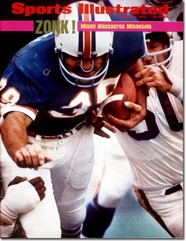
The Miami Dolphins tied the "sacred" Green Bay Packers as the greatest dynasty of the young Super Bowl era by winning its second straight title, 24-7, over the Minnesota Vikings in Super Bowl VIII. "It's hard to find anyone now willing to rate the Pack ahead of the Dolphins or (Packers Coach Vince) Lombardi ahead of the incredible (Dolphins Coach Don) Shula," gushed Hubert Mizell of the St. Petersburg Times. The game marked the Dolphins' third straight Super Bowl appearance. They lost their first in 1972 to Dallas and won their second in 1973 to cap the only perfect season by an NFL team. Although the Dolphins would make numerous playoff appearances over the next two decades and go to two more Super Bowls in the 1980s, the 1974 game remains their last Super Bowl win. • Read the story in the St. Petersburg Times: Csonka Carries Miami To 2nd Straight Super Win
Jan. 12, 1988: Florida Lottery debuts to heavy demand
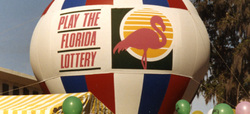
Florida's first lottery game, "Millionaire" debuted to heavy demand throughout the state. The scratch-off game was so popular in its first day that many retailers who began selling the $1 tickets at midnight had sold out by morning. Employees at businesses pooled their money to buy 15, 25 or 50 tickets at a time, the Miami News reported. Convenience store parking lots were littered with instant losers as buyers didn't wait to get home before scratching their tickets. Dade County's first $5,000 winner, transit mechanic Luis Gonzales, immediately called his boss and said he was taking the day off. The game was so successful that the lottery was able to repay its original $15.5 million start up fund in just 17 days. The first terminal games, Florida Lotto and Cash 3, would debut on April 29, 1988. • Read the story in the Miami News: Lottery sales heavy; sellouts reported
Florida Lottery history page
Florida Lottery history page
Jan. 11, 1942: Miami, Dade goes dark in WWII blackout drill
Dade County participated in its first blackout drill for 30 minutes beginning at 10:15 p.m. to determine if residents "are ready to defend themselves to the fullest extent against enemy bombers," the Miami News reported, stating it was "probable" some American cities would be bombed during the year. At the sound of an alarm, residents were ordered to extinguish all lights in their homes and go into a room supplied with water and sanitary facilities they could access without turning on a light. All outside street lights were turned off as well. The drill was witnessed from a Goodyear blimp by Philip Wylie of the Dade County Defense Council, who wrote, "It was a shocking experience to see the luminous, colored patterns of a sprawling city blink and vanish from the vantage point of the sky. I have looked at Miami and Miami Beach and the Gables from the air at night, and the bright design has always seemed ineradicable." Read stories about the blackout in the Jan. 11 and 12 editions of the Miami News
Jan. 10, 1977: S. Fla. called 'car insurance fraud capital of world'
Florida Insurance Commissioner Bill Gunter called The Miami-Fort Lauderdale area the auto insurance fraud capital of the world. Gunter leveled the accusation as he sought additional powers for his department to crack down on fraud. He stated that lawyers become involved in 82 percent of auto accidents in Dade County, compared to only 32 percent in Orange County. Up to 30 percent of all insurance settlements in South Florida are fraudulent, he said. As a result, he said, South Florida drivers pay far higher insurance premiums. Read the story in the Miami News: South Florida car insurance 'fraud capital'
Jan. 9, 1955: Stars hit Silver Springs for underwater premiere
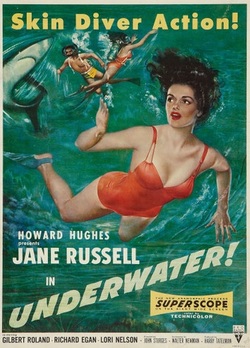
Jane Russell and Debbie Reynolds headed the list of Hollywood stars and national press arriving in Ocala for the Jan. 10 premiere of RKO's Underwater, the first full-length movie ever to be shown underwater, the Ocala Star Banner reported. "Two chartered TWA Super-Constellations are slated to take off from the Los Angeles International Airport at eight o'clock this morning flying non-stop to Tampa," the report said. "The big airliners will land at the Tampa airport, with the trip from there to Silver Springs being made in chartered buses." Two more Super-Constellations were scheduled to arrive from New York, carrying newspaper, magazine and radio personalities, the story said. The film would be projected onto a large reflective screen installed 20 feet underwater at the Springs, with speakers installed under and above the water. Jantzen swim suits would be supplied to the visitors, in case any of them would like to actually go underwater to view the movie. • Read the story in the Ocala Star-Banner: Jane Russell Heads the List of Movie Stars Coming to Ocala For Silver Springs Showing
Jan. 8, 1941: Florida population hits 1,897,414
Urban areas grew faster than rural areas between 1930 and 1940, bringing the state's population to 1,897,414, The St. Petersburg Times reported. In 1930, Florida's population was 1,468,211. Jacksonville was the most populous city, with 173,065, followed by Miami, 172,172; Tampa, 108,391; St. Petersburg, 60,812 and Pensacola, 37,449. • Read the story in the St. Petersburg Times: City's Population Is Set At 60,812 In New Report
Jan. 7, 1964: Daytona Beach sends warning letter to students
Hoping to head off misbehavior by visiting college students in the spring, Daytona Beach's police chief drew praise from city commissioners for an open letter he planned to send to colleges warning students that records of arrests would be sent to the FBI, jeopardizing arrestees' future job prospects. The letter also laid out 10 "don'ts" students must abide by during their spring vacations, including: Don't get intoxicated; don't start fires on the beach or public property; don't drink on streets or sidewalks; don't mark your car with obscene or indecent writings, designs, figures or pictures; don't litter the beach and streets with beer cans or other rubbish; don"t use profane and indecent language in public; don't injure or destroy public or private property; don't camp out on the beach; and don't dress in a manner which could be considered indecent. • Click here to read the story in the Daytona Beach Morning Journal: Rules listed for college students
Jan. 6, 1953: Gov. Daniel T. McCarty inaugurated
From The Florida Historical Society: Daniel T. McCarty, Florida’s 31st governor was inaugurated on this date. McCarty was born to a wealthy family in Fort Pierce on January 18, 1912. He attended the University of Florida and later joined the U.S. Army during WWII, achieving the rank of colonel. Before being elected governor, McCarty was a citrus grower and cattleman, as well as a member of the Florida House of Representatives. As governor, McCarty raised teacher pay, established state scholarships for Florida’s teachers, and helped establish state funded aid programs for the disabled. Unfortunately though, after less than a year in office, Governor McCarty suffered a sudden heart attack and died on September 28th. He was buried near his boyhood home in Fort Pierce at the Palms Cemetery. • Read more at the Florida Historical Society's Facebook page.
Jan. 5, 1923: Carnage at Rosewood draws national coverage
The extent of the racial conflict at Rosewood, in Levy County, becomes apparent to the state and national media as differing news reports emerge.
Click here to read an analysis of how the conflict was covered in various media
That analysis questioned the veracity of this report in the Miami Daily Metropolis
Click here to read an analysis of how the conflict was covered in various media
That analysis questioned the veracity of this report in the Miami Daily Metropolis
Jan. 4, 1940: Pet skunk accompanies drunken owner to jail
A Tampa desk sergeant allowed a pet skunk to accompany its one-legged owner to jail on a drunkenness charge, according to an Associated Press story that appeared in the Palm Beach Post. "Jimmy, a pet skunk robbed in early youth of some of his aesthetic value, was spending the night in the city jail because Jimmy's owner insisted that the pet accompany him to a cell," the story said. The desk sergeant agreed to let Jimmy go to jail with its owner, "'Slim,' a one-legged pencil seller" after Slim vouched for the skunk's "denatured condition," the story said.
Jan. 3, 1971: Lawton Chiles takes his seat in the U.S. Senate
From the Florida Historical Society: Polk County native Lawton Chiles assumed his seat in the U.S. Senate on this date. Arguably one of the most unconventional campaign runs in Florida history, a relatively unknown Chiles walked 1,003 miles from Pensacola to Key West meeting the sunshine state’s constituents face to face in order to gain notoriety. The journey lasted 91 days and he walked through more than one pair of boots. The walk propelled Chiles to an overwhelming victory over his opponent William C. Cramer in the 1970 general election. Chiles would be reelected to the Senate two more times before deciding to run for governor of Florida in 1990, a post he served for two terms. • Read more at the Florida Historical Society's Facebook page.
Jan. 2, 1955: Life ring may be clue to missing ship
Miami-based Coast Guard officials in St. Petersburg searching for a missing ship reported that another ship found a life ring bearing the name of the S.S. Southern Districts in waters southeast of Key West, where the ship was headed. The ship was last heard from on Dec. 4, as it was rounding the Florida Keys in a heavy storm. Twenty-four crewmen were aboard. • Read the story in the St. Petersburg Times: Life Ring May Be Ship Tragedy Clue
Jan. 1, 1959: Two fleeing Cubans land bullet-riddled
air force bomber in Daytona Beach
As the Castro Revolution is under way in Cuba, two Cuban air force officers flee their country and land a bullet-riddled B26 bomber at the Daytona Beach Airport. The two young officers said they were ordered by their commanding officer to flee as rioting broke out in Havana. Meanwhile, evacuating Cuban leader Fulgencio Batista is expected to seek exile again in Daytona Beach. • Read the full stories from the Daytona Beach Morning Journal: 2 Fleeing Cubans Land Air Force Bomber Here
Dec. 31, 1970: Judge says Miami must let Ginsberg finish recital
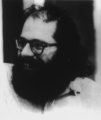 Ginsberg
Ginsberg
Federal Judge C. Clyde Atkins ordered the City of Miami to allow beat poet Allen Ginsberg to finish a poetry recital halted on Dec. 22 by the manager of Marine Stadium who objected to Ginsberg's use of four-letter words. Atkins ruled the manager violated Ginsberg's freedom of speech rights when he first cut off the poet's microphone and then drowned out his voice by piping waltz music over the stadium's sound system. • Read the full story from The Miami News: Ginsberg will finish his recital.

